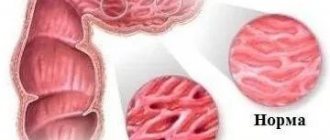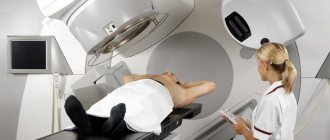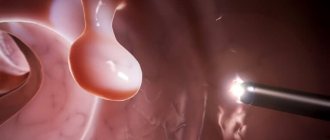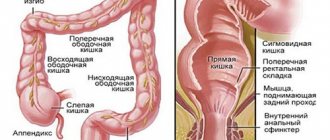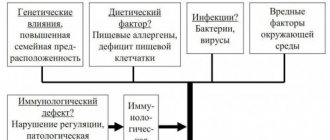Radiation proctitis is an inflammation of the rectum that occurs during radiation therapy for tumors of the pelvic organs. This condition is accompanied by pain in the rectum and anus, painful urge to defecate, diarrhea, and discharge of mucus and blood from the rectum.
The likelihood of radiation damage to the intestinal wall and the development of proctitis is directly related to the total focal dose received during RT. The optimal tolerated total focal dose in the pelvic area is 40-50 Gy. In this case, the probability of developing complications is about 3-5%. When the SOD increases to 65 Gy, radiation proctitis develops in half of the patients.
- Causes of intestinal inflammation after radiation therapy
- Phases of radiation damage
- Classification of radiation proctitis
- Symptoms of radiation proctitis
- How is radiation proctitis diagnosed?
- How is radiation proctitis treated?
- Forecast and prevention of radiation proctitis
Causes of intestinal inflammation after radiation therapy
The following mechanisms underlie radiation damage to the intestine:
- Damage to the intestinal epithelium that develops under the influence of ionizing radiation. This leads to its focal necrosis, desquamation (peeling) and atrophy.
- Development of nonspecific inflammation of the mucous membrane and submucosa. The tissues are infiltrated by neutrophils, hyperemia, swelling, and bleeding are observed.
- Due to trophic disorders (arterioles are damaged), the blood supply to the affected areas of the intestinal mucosa deteriorates, which further aggravates ischemia and necrosis. As a result, atrophic changes progress with the development of fibrosis of the submucosal layer.
- Against this background, pathogenic flora begins to join, which causes infectious complications, including sepsis.
The end result of long-term trophic disorders of the intestinal wall and necrosis is the formation of strictures (narrowing of the lumen), the formation of fistulous tracts, the formation of telangiectasias and the development of bleeding from them.
Phases of radiation damage
Depending on the timing of appearance, early and late radiation damage are distinguished. Early ones make themselves felt directly during radiation therapy, or within 100 days from the date of its completion. This period (100 days, or three months) is the deadline for epithelial recovery from sublethal damage. At this stage, the etiological factor is damage to the intestinal epithelium with the development of inflammatory reactions. If the radiation dose is small, the epithelium is restored quite quickly, and, accordingly, the mucous membrane returns to normal. On average, this takes about 2-4 weeks from the last radiation session.
Late radiation injuries develop 100 days after the end of radiation therapy. During this period, vascular disorders due to damage to the endothelium come first. Its cells become necrotic, and in order to restore them, the remaining endothelial cells begin to actively proliferate. This leads to obliteration of the lumen of blood vessels, the development of thrombosis, ischemia and trophic disorders. As a result, radiation vasculitis develops with bleeding, atrophic processes, fibrous changes, and the proliferation of scar tissue.
Features of the disease
Proctitis is characterized by the development of an inflammatory process in the mucous membrane of the rectum, distributed no more than 15 cm from the dentate line. With the erosive form, defects appear that heal without forming scars.
The disease often manifests itself as general proctological symptoms, therefore, to clarify the diagnosis, appropriate studies are carried out to select the appropriate treatment tactics. Even now, early detection of erosive paraproctitis occurs extremely rarely due to the fact that patients seek help when the process has spread or severe complications have developed.
Classification of radiation proctitis
Depending on the severity, the following types of radiation proctitis are distinguished:
- Catarrhal proctitis. During the examination, a hyperemic, loose, edematous intestinal wall is discovered. There may be increased mucus production. This form of proctitis is considered mild.
- Erosive-desquamative proctitis. This form is manifested by foci of destruction of the epithelium with the formation of erosion - a tissue defect within the epithelial layer.
- Ulcerative proctitis - destruction spreads to deeper layers of tissue and involves the mucous membrane and submucosa in the process.
- Fistulous proctitis. A through perforation of the intestinal wall is formed with access to the pelvic cavity or with the involvement of nearby organs, for example, the bladder or vagina.
There is a classification of radiation proctitis based on the rectoscopic picture:
- There is local redness and friability of the intestinal mucosa, telangiectasias and dilated blood vessels are noted).
- Against the background of hyperemia and edematous intestinal mucosa, ulcers covered with a gray scab are found.
- Against the background of inflammatory lesions, strictures of the intestinal wall are detected.
- Against the background of ulcerative lesions, strictures and fistulas or intestinal perforation are detected.
Symptoms of radiation proctitis
Symptoms of acute radiation proctitis develop within 1-2 weeks after the start of radiation. It can be:
- Diarrhea.
- Pain in the rectal area or lower abdomen.
- Painful urge to defecate.
- Discharge of mucus from the anal canal or its admixture in the stool.
- Anal incontinence.
- Bleeding. In some patients, bleeding is profuse and leads to acute hemorrhagic anemia, which requires blood transfusion.
If there are no symptoms of acute radiation proctitis, this does not mean that long-term consequences will not occur. The frequency of late post-radiation proctitis is about 10% of the total number of cases. There is a latent period that lasts several months or even years. The clinical picture is characterized by the following symptoms:
- Pain in the right iliac region or rectum.
- Frequent stools, tenesmus.
- Presence of blood in the stool.
- When strictures form, constipation and partial intestinal obstruction may occur.
- When fistulas are forced, pathological cloudy vaginal discharge, pneumaturia (air in the urine), loose stools with impurities of undigested food are noted.
Depending on the severity of the disease, there are several degrees of the disease:
1st degree - mild proctitis. Accompanied by mild diarrhea, less than 5 times a day, there may be a discharge of small amounts of mucus and blood.
2nd degree - proctitis with a controlled course. Moderate diarrhea, more than 5 times a day. A large amount of mucus is released and there is bleeding.
3rd degree - proctitis with severe course. There are strictures and bleeding from the rectum requiring surgical intervention.
Grade 4 is a life-threatening course that requires immediate intervention. It is accompanied by intestinal obstruction, fistulas, and heavy bleeding.
Treatment options
Treatment of erosive proctitis is complex and carried out conservatively. The main thing is to consult a doctor in time, before complications appear or the inflammatory process spreads to nearby tissues.
The choice of therapeutic measures is determined by causal factors. After establishing the etiology of the disease, recommendations are made for correcting the diet and diet, which must be followed against the background of drug support.
Non-drug
The main symptoms of paraproctitis can be relieved to a greater extent by correcting the patient’s regimen and diet. At the same time, it is forbidden to resort to the use of traditional medicine, since this is one of the factors that aggravates the process, especially due to the incorrect administration of supposedly medicinal decoctions.
During treatment, semi-bed rest with limited physical activity is indicated. In particular, any activity that is accompanied by an increase in intra-abdominal pressure (severe straining, exercise in the gym, hard work) is prohibited. In addition, this measure indirectly minimizes the likelihood of stress factors influencing the therapy.
When modifying your diet, you should adhere to the following recommendations:
- Food is taken in small portions, but often - up to 6 times a day at the same time. You should try to make the breaks approximately equal;
- Any food that can cause irritation of the rectal mucosa is excluded from the diet - fatty meats, fried foods, smoked foods, spices, spicy or pickled foods;
- Reduce (but do not eliminate) the amount of consumed plant fiber or laxative products that can cause stool thinning - fresh vegetables and fruits, sour juices, prunes, dried apricots, figs, raisins, kefir, fermented baked milk, yogurt, beans, white cabbage and others;
- Complete abstinence from alcoholic beverages during treatment and rehabilitation;
- The body must not be dehydrated. Take a moderate amount of liquid in the form of still mineral water, lightly brewed tea or unsweetened compotes.
Medication
Medicines or procedures are prescribed only by a qualified doctor, often a proctologist or general surgeon. This becomes possible only after conducting an appropriate diagnostic search, which exactly confirms the nosological unit. The choice of medications will depend on the causally significant factors that influenced the development of the disease. The following medications may be prescribed:
- For etiological treatment - antibiotics or antiparasitic drugs in accordance with the clinical picture and the suspected pathogen. Sometimes it is necessary to use broad-spectrum agents without waiting for the results of a stool test (this can take from several days to a week);
- For symptomatic treatment, antispasmodics (No-spa) and antihistamines (Suprastin) are prescribed. They allow you to reduce
severity of inflammation and pain. - For local exposure:
- Therapeutic enemas. Their setting is carried out only after training the patient or in a hospital setting by medical personnel. To do this you will need a rubber bulb or syringe. They are filled with a warm solution with the addition of “Protargol” or decoctions of the indicated medicinal plants (chamomile, St. John’s wort, string, oak bark).
- Rectal suppositories containing the substance “methyluracil”.
In exceptional cases, the proctologist may recommend sitz baths with chamomile infusion or other agents that accelerate healing as a supplement to the main therapy. Surgical treatment is resorted to when complications of paraproctitis develop, so it is better to prevent this and consult a proctologist in a timely manner.
How is radiation proctitis diagnosed?
Diagnosing diseases is not difficult. The key point here is the presence of a history of radiation therapy and its effect on the pelvic organs, increased frequency of stool, and the presence of pathological impurities in it.
If the course is prolonged, it is recommended to examine the rectum using a rectoscope or endoscope. This will allow you to detect multiple erosions, scar deformation, atrophic changes and telangiectasias and decide on the need for endoscopic or surgical treatment.
How is radiation proctitis treated?
If symptoms of radiation proctitis develop during radiation therapy, a revision of the radiation regimen is required. For mild damage, it is enough to increase the intervals between sessions. In more severe cases, the question arises of reducing the total focal dose or even canceling radiation therapy. In addition, treatment is required, which includes several areas:
- Diet food. An important part of the treatment of post-radiation proctitis is dietary nutrition. Food should contain an increased amount of protein, a sufficient amount of macro and micronutrients. It should also be chemically and physically gentle, i.e. you should avoid spicy, pickled, and canned foods. In addition, coarse plant fiber should be avoided so that it does not injure the already damaged intestinal wall.
- Conservative methods include drug therapy, therapeutic enemas, suppositories, etc. As part of independent treatment, it is used only for mild and moderate pathology; in other cases, it is used as part of complex treatment together with other treatment methods.
- Endoscopic methods - radiofrequency ablation, argon plasma coagulation, etc. Currently, these methods are the gold standard for the treatment of chronic forms of the disease and are mainly used to eliminate bleeding.
- Surgical methods include removal of the rectum with a stoma or coloanal anastomosis. They are used in severe cases when there is a threat to the patient's life. Surgical operations are used to eliminate strictures, fistulas and perforations of the intestinal wall.
Drug therapy for radiation proctitis
The following groups of drugs are used for drug therapy:
- Glucocorticosteroids are the main group of drugs used for moderate and severe proctitis. GCS have a powerful anti-inflammatory effect.
- Analgesics. Different groups of drugs are used, including narcotic drugs.
- 5-aminosalicylic acid (mesalazine) - has an anti-inflammatory and protective effect, thereby protecting the affected mucosa and stimulating its recovery.
- Antidiarrheal drugs. Enveloping and astringent agents and antispasmodics are used.
- Antibacterial drugs. They are prescribed for the treatment or prevention of bacterial complications of proctitis.
Given that the rectum is the terminal part of the digestive tract, many topical drugs are not effective enough when used in forms intended for oral administration. Therefore, preference is given to forms for local use - suppositories, enemas, powders, etc. They act directly on the intestinal wall and have an effect in the shortest possible time.
Surgical treatment of radiation proctitis and radiation injuries of the rectum
Surgical treatment is aimed at eliminating specific symptoms or complications of post-radiation proctitis. This may include continuous bleeding, fistulas and perforations of the intestinal wall, or strictures. Very rarely, surgery is used to relieve uncontrollable pain.
Before planning an operation, it is important to take into account that radiation damage reduces the regenerative capabilities of the tissue, so there is a high risk of complications, including bleeding, poor wound healing, infection and its generalization, as well as long-term negative effects such as severe scarring or anal sphincter failure.
Thus, classical surgical interventions in the acute period are risky, they do not allow complete control of bleeding and can lead to severe, life-threatening complications. Therefore, they are mainly used to eliminate the long-term consequences of radiation proctitis.
Endoscopic treatment methods
Endoscopic treatment methods are safer. They are based on the destruction of the affected part of the intestinal mucosa, followed by necrosis and replacement by healthy epithelium. For this purpose, radiofrequency ablation is used in particular. The method is based on local controlled heating of tissue to produce a thermal burn. The energy source here is radio frequency waves.
During the procedure, a special catheter is inserted into the patient's rectum, which will emit waves and heat the tissue. The standard depth of necrosis is several tenths of a millimeter, so 1-3 pulses are needed to treat one area of the mucosa. The energy intensity is adjusted automatically based on the current temperature of the tissue being treated. This allows you to avoid “overheating” and deep burns.
The advantage of endoscopic treatment is its bloodlessness, a high degree of control during the intervention, and quick results. It is most effective for bleeding. With just one procedure, you can coagulate all pathological blood vessels and stop even heavy bleeding. As a rule, for maximum results, the procedure is carried out 2-3 times at intervals of several months.
Prognosis and prevention
Prevention of the development of complications is the timely treatment of any acute gastrointestinal diseases, as well as observation by a doctor and correction of chronic diseases of the stomach and intestines.
The prognosis for proctitis is generally favorable: with proper treatment, it is possible to completely eliminate the manifestations of the acute form of the disease. Treatment of chronic proctitis lasts almost a long time, and episodes of exacerbations are possible. The success of therapy depends on the individual characteristics of the body, as well as on compliance with the treatment plan.
At the CELT clinic, leading specialists consult on your health issues. Polite and friendly doctors will help you recover. The CELT proctology service offers consultations with high-class proctologists. Start treatment on time and you won’t have to suffer from the disease for years.
Make an appointment through the application or by calling +7 +7 We work every day:
- Monday—Friday: 8.00—20.00
- Saturday: 8.00–18.00
- Sunday is a day off
The nearest metro and MCC stations to the clinic:
- Highway of Enthusiasts or Perovo
- Partisan
- Enthusiast Highway
Driving directions
